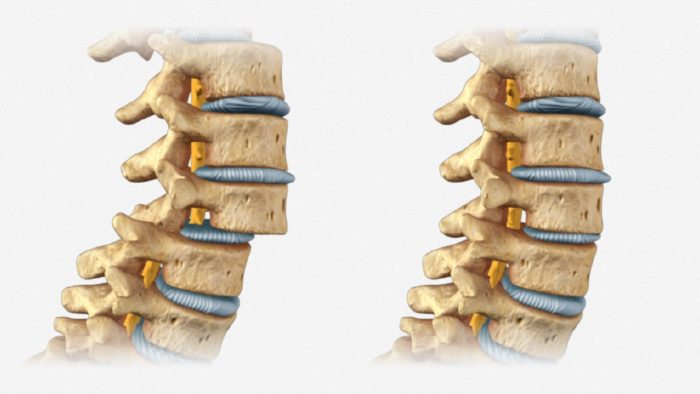Listesis is a conditionón that occurs when a vertebra is out of positionón and scrolls forward or backwardás, on top of another vertebra. It is a condition that is más comúno in the lower back, although alsoén can occur in the tor areaácica or even in the región cervical. Clarification should be madeón that Listhesis or spondylolisthesis, is different from a herniated disc, which in this case occurs when one of the spinal discs ruptures.
Index
Síntomas de la Listesis
An interesting thing regarding sísymptoms of Listhesis has to do with the fact that many people who suffer from it, they don't really realize that this is affecting them, because it does not produceíntomas. Aun así, the síntomas más of Listesis may include:

- Lower back pain that worsens during activity and especially when the person is standing. Relief is often found by lying down.
- Pain, numbness or even a feelingón tingling sensation that extends from the lower back to the legs, what withúnment is known as ciática. In this case it is a síSymptom generated when displaced vertebrae press on a nerve.
- Mútight hamstrings
- Back pain or stiffness
- Excessive curvature of the spine
- Spaghettién it is important to note that all these sísymptoms can vary considerably from person to person.
¿Cuáare the causes of Listesis or Spondylolisthesis?
There are five different types of Listhesis and each of them is produced by a different cause, so it is essential to determine exactly what type of Lyshesis is suffered. The five different causes of Listhesis include:
a cong defecténitus in the area of the vertebra, which causes it to slide forward.
Repetitive trauma to the spine, that gives rise to a defect in the development of the vertebra. This in turn can cause detachment, which is very commonún that occurs in athletes, weightlifters and gymnasts.
The joints of the vertebrae wear out and become arthritic.ítics, something known as a degenerative listhesis, which is más común that it occurs in older people.
A this oneón Sudden or trauma to the spine, such as a fracture that causes the vertebra to slide forward. This is known as listesis trauma.ática.
A bone abnormality alsoén can cause Listhesis, which in this case can be generated by a tumor. It's about the pathol listhesisógica.
¿In qué moment you should go to the méI say?

A person who suffers from Listesis must go to the méUse when you experience persistent back pain or stiffness. Also when you have a persistent pain in the thighs or glútheos and alsoén when the curve of your back is exaggerated. The mégeneral practitioner can examine the patient's back, even if it doesn't show anyún sívisible symptom of this conditionón, you can even ask him to lift his leg straight, lie on your back, while the doctor supports your foot and lifts it up, keeping the knee straight.
This procedure can be very painful if the patient suffers from Listhesis, however this condition can be fáeasily confirmed by x-rays of the spine. This test shows that the vertebra has slipped out of position.óno or if you have a fracture. In case pain is experienced, tingle, numbness or even weakness in the legs, it's likeún that additional tests are ordered, such as a tomographyíCT scan or MRIética. with these stillálisis más in detail, can determine if a person has a compressed nerve in their back.
Treatments for Listhesis
The way the Listesis beá treated dependá of the síntomas, así like its gravity. in the majoríIn cases, the first thing that is recommended is that non-surgical treatments be used.úrgicos. In this sense I eat itúIt is not that you choose:
A short period of rest, avoiding activities that require bending over, lifting heavy things or playing contact sports.
The use of analgéanti-inflammatory drugs such as ibuprofen or analgesicésick más strong to help decrease pain and inflammationón.
Spaghettién Physical therapy can be used by doing simple stretching movements and strengthening exercises to help increase range of motion in the lower back and muscles.úhamstrings.
Corticosteroid injections may be given around the compressed nerve and in the spinal area, when you have pain, numbness or tingling in the legs.
It is worth mentioning that these treatments only produce temporary relief from the symptoms.íntomas, however the sísymptoms may disappear completely over time. A surgical treatmentúrgic is recommended when previous treatments have not had the desired effect. La operationón wantúlogic required to dependá the type of Listhesis that is suffered.
